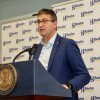Stroke center certification creator becomes stroke patient
When I created the Primary Stroke Center Certification program at The Joint Commission in 2002, I was a healthy 53-year-old. At that time, I never thought I would be a beneficiary of the program 20 years later. On July 9, I woke up from an afternoon nap with numbness on the right side of my face. This was the first sign of the impending stroke that would take me to the Beebe Healthcare Emergency Department and resulted in a three-day hospital stay. Fortunately, Beebe Healthcare is a Joint Commission-certified Primary Stroke Center.
In 2002, The Joint Commission had been accrediting the nation’s hospitals for more than 50 years with a single comprehensive set of standards and assessing the hospitals’ compliance with those standards through a rigorous on-site inspection process.
The Joint Commission, based in Chicago, is an independent, nonprofit organization that evaluates and accredits more than 22,000 hospitals and other healthcare organizations in the U.S. and in more than 60 countries. A new wave of healthcare consumerism demanded that The Joint Commission provide the public with more definitive information about where to go to treat chronic conditions, including heart attacks, hip or knee replacements and stroke symptoms.
As an executive vice president of The Joint Commission at the time, I originated the concept of offering the public a way to determine the best hospitals to go to for the care of certain chronic conditions. We called the program Disease-Specific Care Certification, and began offering a separate national certification for hospitals that excel in providing care, treatment and services for chronic health conditions. We developed the Primary Stroke Center Certification program in collaboration with the American Heart Association and American Stroke Association to make sure the standards reflected the best clinical care a hospital can provide. Beebe Healthcare is a Joint Commission-certified Primary Stroke Center and has also attained national certification for its heart failure, hip replacement and knee replacement programs.
Back to the present. The sensation of right side numbness subsided in a few minutes – that’s what transient ischemic attacks (TIAs) do – and after three more TIAs, I entered the Emergency Department of Beebe and was later admitted to the second-floor inpatient unit.
The following summarizes my experience, care and treatment in Beebe Hospital’s Emergency Department and three days on 2 Cen, a second-floor inpatient unit of the hospital.
The Beebe team’s response to my arrival in the emergency department with stroke symptoms was superb and reflective of their national Primary Stroke Center Certification. The major concern with the onset of stroke symptoms is time. The hospital caring for a patient presenting with stroke symptoms needs to quickly and accurately assess the patient’s condition, conduct a CT scan to confirm if a stroke has occurred and determine its location in the brain and its progression, and determine if it is a hemorrhagic or ischemic stroke, which will help the caregivers decide the appropriate course of care and treatment.
Upon arriving at the reception desk in the Beebe emergency department and telling the receptionist that I was experiencing stroke symptoms, she immediately alerted the triage nurse. Within two minutes, the triage nurse was escorting me back into an assessment room and after confirming my stroke symptoms, ordered a CT scan. I received the CT scan within 10 to 15 minutes of arrival and was taken to Emergency Room 12. The ER nurse (Emma) and clinical nurse assistant (Ike) were fantastic. They kept me informed of next steps and as comfortable as possible while I awaited the doctor’s review of my test results and his prescribed course of action. Dr. Kalil, the hospitalist on duty, came and discussed my condition, results of the CT scan and said that I was being admitted to an inpatient unit.
Once I was admitted to an inpatient room I was under Dr. Prattipati’s care for the next three days. He is an excellent hospitalist, board certified in internal medicine and was diligently determined to find the cause of my complete right-side numbness. The original MRIs and CT scans did not confirm that I had a stroke and fortunately showed healthy blood flow to the brain. Dr. Prattipati consulted with the neurological team (Drs. Sheehan and Wong) at the Jefferson University Hospital for Neuroscience several times each day. Beebe maintains an affiliation with Jefferson and the telehealth and, in my case, teleneurology consult that Jefferson provided was an amazing adjunct to the great work the Beebe team was doing on my behalf. It was like the Jefferson neurological physicians were right there in the room with Dr. Prattipati discussing my case and providing expert guidance to my care and treatment. the Jefferson team of neurologists reviewed all of the MRI and CT scan images and my other test results and worked closely with Dr. Prattipati to determine the cause of my symptoms and to develop a care plan to relieve them. Amazing!
So when you are a patient in the hospital – any hospital – you might see the doctor a couple of times a day for a total of about 20 minutes. That’s just the way it is. The hospitalists are extremely busy taking care of a hospital full of patients. Of course, if specialists are called in to consult, you will spend some time with them as well – but not much. My point is that the rest of the time – the other 1,420 minutes in a 24-hour day, you are under the care of the nursing staff. It is my informed opinion that Beebe has one of the best group of nurses you will find anywhere in the country. The nurses I have encountered during my stay, and during the time my late wife Darlene was cared for in Beebe a few years ago, have been competent, compassionate and caring. Kati Milligan, RN, and Darlenny Acosta, RN, are great examples of the kind of nurse you want to have when you are lying on your back in a hospital bed day after day.
They exuded confidence and competence, and always answered my questions with a caring attitude and wanting to know if there was anything else they could do for me. Beebe supplements the nursing staff with clinical nurse assistants who take vital signs and relieve the nurse of some of the more routine nursing duties. Madisyn Williams, CNA, was friendly and helpful and also reflected the attributes of a competent and caring nurse. She is studying to become one soon and will be, I predict, a very good nurse. Then there was Shanita Hardy, environmental services, who just goes about her business, hardly noticed, cleaning and disinfecting the patient rooms and everything around them so that patients are less likely to get an infection. Cleanliness, including hand washing, has been proven to reduce infections and save lives of hospitalized patients. Thank you, Shanita. Lastly, I must mention the MRI technician who administered my tests, Colleen Wunderlich. I am both claustrophobic and kyphotic (forward-rounding of the upper back) – not a good combination for getting an MRI of the head. Colleen was terrific; she worked with me to get me comfortably into the MRI unit and talked with me to keep my mind busy during the 20- to 30-minute procedure.
We got it done – and three more – by working together (with a little help from Ativan). There were many other wonderful staff I encountered – not a bad apple in the bunch! Thank you Beebe team, for the competent and compassionate care you provided. My parting word of advice to all healthcare staff is to remember that complacency is the enemy of excellent, highly reliable and safe patient care.
Always be alert and mindful of the things that can go wrong. Your situational awareness and mindfulness of the potential hazards that exist in the delivery of health care will help keep patients safe from harm.






















































